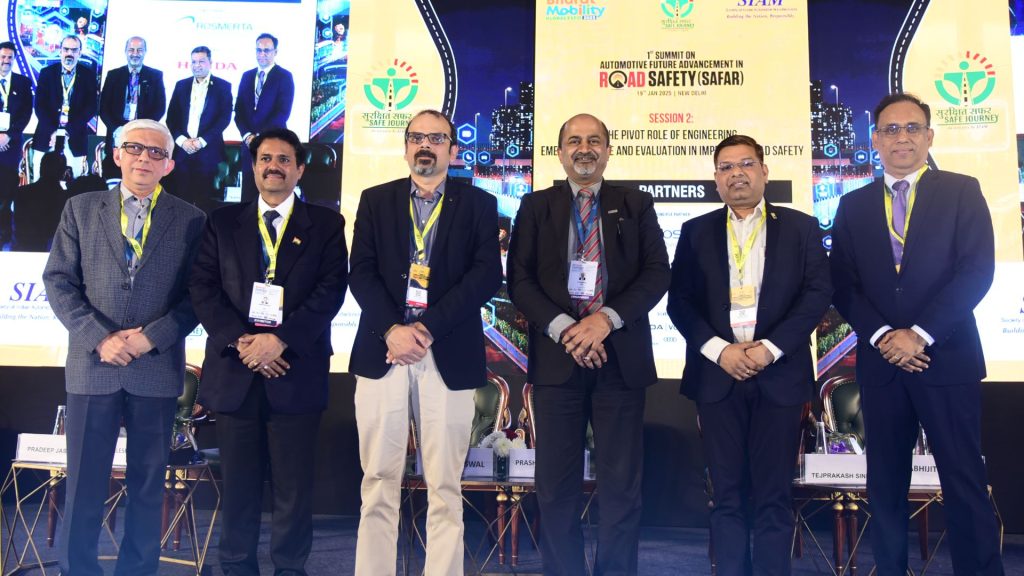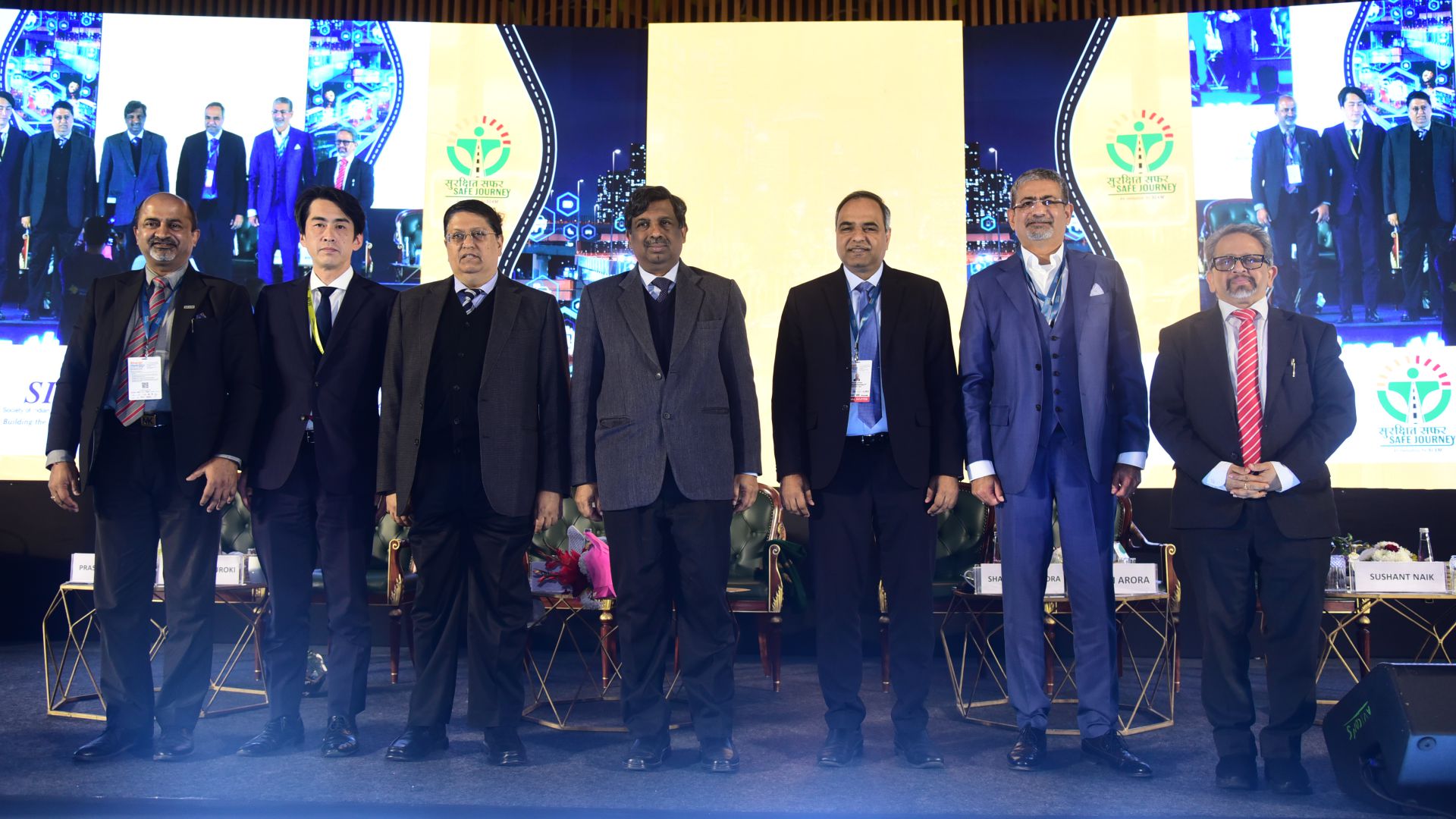New Delhi, January 19, 2025: The Society of Indian Automobile Manufacturers (SIAM) successfully organized the 1st Summit on Automotive Future Advancement in Road Safety (SAFAR) today at Bharat Mandapam, Pragati Maidan, New Delhi, on the sidelines of the Bharat Mobility Global Expo 2025. The event, themed “United Efforts for Road Safety: Safer Roads, Our Responsibility”, aimed to foster collaborative approaches to improving road safety in India through impactful discussions, interactive activities, and innovative initiatives.
The summit commenced with an opening session, where key dignitaries addressed the audience on “Driving a People-Centric Future: A Vision for Safer Roads in India”, and included two impactful Panel Discussion Sessions. The sessions featured high-level discussions, engaging strategies, and innovative initiatives to address key challenges and solutions for road safety.
During the Opening Session, the SIAM’s “Surakshit Safar Initiative Report (2025-2026)” booklet was launched by the Chied Guest Mr. V Umashankar, Secretary, Ministry of Road Transport & Highways, Government of India, which offers a comprehensive coverage of SIAM initiatives on road safety in FY25.
Welcoming the dignitaries, Mr. Prashant K Banerjee, Executive Director, SIAM, said, “This is a momentous occasion as we organize this significant event during Road Safety Month. With 80% of India’s annual vehicle population comprising two-wheelers, who are among the most vulnerable road users, it is crucial to address this concern. This is the perfect time to reaffirm our commitment to safer roads and responsibly contribute to nation-building.”
Chief Guest Mr. V. Umashankar, Secretary, Ministry of Road Transport & Highways, Government of India, said, “The implementation of RVB framework—Road, Vehicle, and Behaviour—could yield better results in terms of road safety. Road engineering is critical; it can help us reduce accidents significantly. Vehicles should be equipped with advanced safety features, and drivers must follow guidelines for using them. Behavioural modification through education and awareness is crucial to improving road safety.”
Guest of Honour Mr. Sanjay Bandopadhyaya, Member, the Supreme Court Committee on Road Safety, said, “India’s federal structure, with its diverse states and large population, poses unique challenges. Reviving India’s age-old value of ‘Pehle Aap’ could significantly reduce road fatalities. We need focused interventions in vehicle technologies, emergency care, and enforcement. We can achieve the ambitious target of halving road fatalities and making our roads safer for everyone by collaborating effectively.”
Mr. Shailesh Chandra, President, SIAM & Managing Director, Tata Motors Passenger Vehicles & Tata Motors Electric Mobility, said, “The name SAFAR symbolizes a shared roadmap for a safer and more sustainable future. We must strictly follow the 4E model of road safety: Education, Enforcement, Engineering, and Emergency. We have to educate people and drivers about road behaviour, ensure enforcement of rules and regulations, improve vehicle engineering, and ensure a better emergency response system. Advancing vehicle technologies, leveraging data analytics to identify high-risk zones, and deepening collaboration will facilitate India’s road safety efforts.”
Mr. Piyush Arora, Managing Director & CEO, SKODA AUTO Volkswagen India, said, “Bharat NCAP is a commendable step by the government, which strengthens India’s position in road safety. Our aim is to set new safety benchmarks for our customers while incorporating the most stringent safety standards. We are committed to supporting Bharat NCAP and helping address India’s unique road safety challenges.”
Mr. Kazuyoshi Kuroki, Chief Engineer, Honda Motor Co. Ltd., presented insights into Japan’s road safety measures and said, “Road safety follows the principle of education, enforcement, and engineering. Both public and private sectors have a crucial role to play. We must emphasize creating appropriate education programs, implementing effective laws and regulations, and ensuring collaboration.”
Mr. Sushant Naik, President, SAFE and Global Head, Govt & Public Affairs, Tata Motors, said, “Safer roads mean safer families, and it is our shared responsibility to bring meaningful change. Building a people-centric future reminds us that road safety can only be achieved through cutting-edge innovation. While progress has been made, challenges remain that need to be addressed.”
The First Panel Discussion Session, themed “Saving Lives by Adopting Multi-pronged Road Safety Strategies through Education and Enforcement”, focused on the significance of improving education and enforcement strategies, considering actionable recommendations, and strengthening collaboration. While moderating the session, Mr. Alok Jaitley, Vice President, SAFE and EVP, Maruti Suzuki India, said, “Technology must be made more affordable so that more Indian customers can benefit from advanced safety features. We are optimistic about seeing these technologies become standard in vehicles across the country.”

Mr. K K Kapila, President Emeritus, International Road Federation (IRF), said, “By focusing on the 4 E’s—Engineering, Education, Enforcement, and Emergency Response—we can drastically reduce accidents and nearly eliminate fatalities. A critical part of this is educating schoolchildren about road safety from an early age to instill responsible behaviour.”
Mr. Akash Passey, President, ZF India, said, “Over the last decade, many countries have successfully reduced road fatality rates, showing us what can be achieved with concerted efforts. Ultimately, it also depends on what customers prioritize and are willing to pay for when it comes to safety.”
Mr. Ramashankar Pandey, Social Defence Fellow of the Indian Administrative Fellowship at the Ministry of Social Justice and Empowerment & Former MD, Hella India Lighting Ltd., said, “India has made significant strides in vehicle safety regulations, emerging as a global leader in this domain. However, true change comes when behaviour aligns with science. A balanced approach is essential while combining regulation with proactive solutions like alert and assist systems.”
Mr. K C Sharma, Chief Engineer, MoRTH, said, “Education of vehicle owners is extremely important. Enforcement of already existing laws is essential to prevent what is happening in terms of road fatalities.”
The second and last Panel Discussion Session, themed “Pivotal Role of Engineering, Emergency Care and Evaluation in Improving Road Safety”, focused on collaboration among stakeholders, public awareness and engagement in road safety efforts. Mr. Prashant K Banerjee moderated the session, which was graced by road safety stakeholders across the industries.

Mr. Akhilesh Srivastava, President, ITS India, said, “We need advanced systems like ATMS (Automated Traffic Management Systems) to leverage data and analytics for improving road safety. We must implement measurable data points to incentivize good driving while addressing poor driving behaviour. Piloting such technologies can significantly enhance road safety efforts.”
Mr. Manish Jaiswal, Director, NATRAX, said, “Road safety is a complex challenge that demands comprehensive solutions, including better road infrastructure and improved vehicle engineering. Vehicle safety is a multifaceted issue as it’s the culmination of various factors working together.”
Mr. Abhijit Sengupta, Senior Director & Head of Business- Southeast Asia, HERE Technologies, said, “In our recent survey conducted with 1,300 drivers, we found that more than half of the respondents reported experiencing accidents in the last two years, this highlights the necessity of redefining and tackling key contributing factors behind the same. Behaviour emerged as the most significant factor, followed by road conditions and the enforcement of laws.”
Dr. Tejprakash Sinha, Co-Director, WHO, said, “We must enhance responsiveness in road safety interventions. Immediate healthcare assistance can save 30-40% of lives. Community-driven ambulance services can complement efforts, especially since 40-60% of accident victims are transported by private vehicles. The government is making commendable strides in increasing ambulance availability and their services. Establishing zero-fatality corridors can further boost road safety outcomes.”
Commander Mr. Pradeep K Jaiswani, COO, JP Research, said, “AI can play a critical role in road safety by identifying patterns and using data as a key intervention tool. With technology, we can capture the moments leading up to crashes and apply automated corrective measures. Data is pivotal across technology, healthcare, and policymaking.”
The summit also featured a range of interactive activities for public engagement and road safety awareness, including the “Road Safety Awareness Run”, with participation from over 1,200 students. The event was flagged off by the summit’s Chief guest. Highlighting the importance of road safety, the run was organized on the side of the Surakshit Safar Pavilion (सुरक्षित सफर) which beckons attendees through its four gates for 4Es of Road safety. With interactive VR games, simulators, vehicle models as well as “CPR Training & Certification” on display, the pavilion saw great participation from visitors.
Additionally, school students showcased their creativity through competitions including poster-making, show and tell, extempore speech, road safety qawwali, nukkad natak (street play) on road safety themes, and daily street plays. Attendees also experienced an immersive VR journey into road safety, focusing on two-wheeler riding safety, four-wheeler driving safety, and pedestrian safety awareness.











